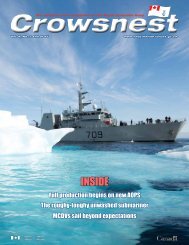Create successful ePaper yourself
Turn your PDF publications into a flip-book with our unique Google optimized e-Paper software.
Even in areas that directly intrude upon geo-politics, <strong>the</strong> possibility exists <strong>of</strong> multilateral<br />
cooperation in <strong>the</strong> maritime sphere. Perhaps one <strong>of</strong> <strong>the</strong> most interesting recent examples is <strong>the</strong><br />
Convention on Unplanned Encounters at Sea (CUES). Signed at <strong>the</strong> Western Pacific <strong>Naval</strong><br />
Symposium in 2014, it is specifically designed to prevent unexpected at-sea aggravations between<br />
navies, particularly <strong>the</strong> USN <strong>and</strong> PLA(N), from flaring into a serious international confrontation<br />
with unforeseen consequences. CUES might, <strong>the</strong>refore, be regarded as a form <strong>of</strong> pre-crisis<br />
management. It is intended to reduce <strong>the</strong> possibility <strong>of</strong> miscalculations <strong>and</strong> unintended escalation<br />
at sea <strong>and</strong> is “a non-binding voluntary agreement to follow set procedures for communicating<br />
with o<strong>the</strong>r military forces encountered at sea or in <strong>the</strong> air.” 309 At <strong>the</strong> tactical level, it creates a<br />
safer operating environment by helping to make certain that intentions <strong>of</strong> naval vessels <strong>and</strong>/or<br />
fleets are not misunderstood. At <strong>the</strong> strategic level, it is useful in maintaining open channels <strong>of</strong><br />
communication at a time when tensions in Asian waters are rising <strong>and</strong> naval forces might be<br />
unfamiliar with one ano<strong>the</strong>r. By reducing <strong>the</strong> potential for escalation, CUES is widely regarded as<br />
a success by translating tactical confidence into strategic stability.<br />
<strong>The</strong> possibility <strong>of</strong> finding common ground on all, or even <strong>the</strong> most, pressing maritime problems is<br />
none<strong>the</strong>less precluded by <strong>the</strong> immensity <strong>of</strong> <strong>the</strong> maritime realm, <strong>the</strong> complex issues that need to be<br />
addressed, <strong>and</strong> <strong>the</strong> breadth <strong>of</strong> contending interests among states. Efforts at comprehensive<br />
regulation—e.g., in <strong>the</strong> Mediterranean Sea or among <strong>the</strong> members <strong>of</strong> <strong>the</strong> Association <strong>of</strong> Sou<strong>the</strong>ast<br />
Asian Nations (ASEAN)—have so far failed due to a broad array <strong>of</strong> conflicting economic<br />
interests, national sensitivities or mutual distrust. 310 ASEAN <strong>and</strong> its subsidiary bodies (e.g., <strong>the</strong><br />
ASEAN <strong>Maritime</strong> Forum—AMF, ADMM+—ASEAN Defence Ministers Meeting Plus, <strong>and</strong> <strong>the</strong><br />
ASEAN Regional Forum—ARF), to select one multilateral organization, have gone far in<br />
institutionalizing dialogue <strong>and</strong> information exchanges, but far less progress has been made in <strong>the</strong><br />
areas <strong>of</strong> effective cooperation on maritime security-related items <strong>and</strong> joint enforcement. 311 <strong>The</strong><br />
Declaration on <strong>the</strong> Conduct <strong>of</strong> Parties in <strong>the</strong> South China Sea (2002), between ASEAN<br />
member-states <strong>and</strong> China is one such example. 312 Its formal adoption is generally regarded as a<br />
positive contribution towards dampening regional tensions, but its application has proven more<br />
difficult. 313 While <strong>the</strong> positive outcome <strong>of</strong> <strong>the</strong> negotiations is important <strong>and</strong> might even have a<br />
salutary impact on regional politics, <strong>the</strong> reliability <strong>of</strong> any international confidence-building<br />
mechanism flows directly from its practical utility. In this case, <strong>the</strong> clash <strong>of</strong> exclusive national<br />
interests, namely maritime boundaries is reinforced by <strong>the</strong> enormous asymmetry between China<br />
<strong>and</strong> <strong>the</strong> o<strong>the</strong>r members <strong>of</strong> ASEAN. 314<br />
309 Ankit P<strong>and</strong>a, “Unplanned Encounters in <strong>the</strong> South China Sea?”, <strong>The</strong> Diplomat, 25 January 2016.<br />
310 United States Senate, Committee on Foreign Relations, Re-Balancing <strong>the</strong> Rebalance: Resourcing U.S.<br />
Diplomatic Strategic in <strong>the</strong> Asia-Pacific Region – A Majority Staff Report (Washington, D.C., 2014),<br />
pp. 19–20. See also Holslag, Crowded, Connected <strong>and</strong> Contested – Security <strong>and</strong> Peace in <strong>the</strong> Eurasian Sea<br />
<strong>and</strong> What it Means for Europe, p. 13.<br />
311 See Hao Duy Phan, “Institutional Building for <strong>Maritime</strong> Security in Sou<strong>the</strong>ast Asia: <strong>The</strong> Bodies <strong>of</strong><br />
ASEAN”, in Nordquist et al., Freedom <strong>of</strong> Navigation <strong>and</strong> Globalization, pp. 167–186.<br />
312 Association <strong>of</strong> Sou<strong>the</strong>ast Asian Nations, Declaration on <strong>the</strong> Conduct <strong>of</strong> Parties in <strong>the</strong> South China Sea,<br />
4 November 2002 [accessed on 15 April 2015 at www.asean.org/asean/externalrelations/china/item/declaration-on-<strong>the</strong>-conduct-<strong>of</strong>-parties-in-<strong>the</strong>-south-china-sea].<br />
313 Shen Dengli, “Positive Steps in <strong>the</strong> South China Sea”, <strong>The</strong> Diplomat, 2 August 2011.<br />
314 Shannon Tiezzi, “Why China Isn't Interested in a South China Sea Code <strong>of</strong> Conduct”, <strong>The</strong> Diplomat,<br />
26 February 2014.<br />
DRDC-RDDC-2016-R085 65




